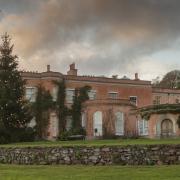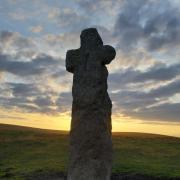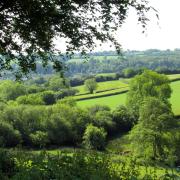As a child, one of our family walks from home was this one. It has lovely memories for me: a gorgeous dog who lived en route called Womble, superb views and the intriguingly named Firebeacon Farm. Decades have passed and dear old Womble is long-gone, but the views are still glorious, the hills seem pleasingly less steep than they did to my juvenile legs, and the land that is in the custodianship of the National Trust’s Knightshayes Court is appealingly accessible.
Knightshayes tells me that all their footpaths are permissive rights-of-way, and the parkland and woodland is completely free to access for non-members, as long as everyone complies with the signage (particularly with regards to grazing animals). They do ask that, if walkers are trust members, please pop into visitor reception to scan membership cards ‘as we get money from a central pot for every membership card we scan – all of which is spent on caring for Knightshayes’.
And I recommend you also pop in for a welcome post-walk cuppa as that helps their funding too.
THE ROUTE

1. Leave the car park and walk out past the former stables courtyard, a striking Victorian Gothic edifice that now houses the shop, bookshop and café.
Follow the drive by which you arrived, passing the side of the even-more-impressive mansion, completed in 1873 for the Heathcoat-Amory family, whose forbears had invented the mechanised bobbin lace-making machine and who owned a lace-making factory in Tiverton (which still exists). Royal wedding veils have been made by Heathcoat’s since Queen Victoria’s wedding and, more recently, the factory made the parachute for the 2020 Mars landing.

Follow the main drive away from the house, walking back the way you drove in. Soon you have metal railings to right and left; keep your eyes open for the first metal gate on the right, leading off the drive. Admire the design of its latch and go through, then bear diagonally left across the grass through parkland trees, with sloping ground down to the right. The cricket pavilion is soon visible ahead and as you approach it you pass a bench near an arrowed post.

2. From here, start to bear right, keeping the cricket pavilion still over to your left and dropping down towards the right-hand fence in the parkland.
Follow the path alongside this right-hand fence. It arrives at a gate leading onto a sunken path that leaves the bottom corner of Knightshayes’ parkland. The path widens out to meet a crossing track; bear left, downhill, passing a pair of white houses and arriving at a lane in the village of Bolham. Turn right towards the old railway bridge, which, until the 1960s, carried the Exe Valley Line.

3. Before you reach the bridge turn right again along the signed footpath, admiring the lofty, more elegant fingerpost that shows you’re heading towards Hayne, Home Farm and Marley. The lane passes attractive, stone-built Bolham Halt Cottages, the name redolent of their former proximity to trains.
There now follows a long plod up the surfaced footpath. As you climb, and trees permitting, westward views open up across the Exe Valley to the left. You reach Hayne and soon the way turns right, still climbing and passing an open-fronted linhay on your left – one of the buildings of Knightshayes Home Farm.
Just after this the path reaches a T-junction. A private road goes to the right, so we go left towards white-painted Home Farm Cottage. Continue on past a redbrick cottage and enjoy a downhill stretch until the path swings left and starts to climb again, soon passing through the entrance gate to Old Stable Cottage and Marley Farm.

The track rises to a gate and, just before it, a double-arrowed post makes absolutely sure that you turn left along a narrow, hedged path with expansive views to the left over a textured landscape.

As the path swings right Firebeacon Farm comes into view – the lower of the white houses on the hillside ahead. Pass through an arrowed gate then continue through the field alongside the right-hand hedge – the path becomes separated from the field by scrubby hedge to the left, but if the way is overgrown you can walk on the other side of this scrub, still within the same field.
Continue through the field along the right-hand hedge, passing the end of an old tree boundary that slithers down the hill to the left, see if you can spot its ‘tortoise head’. The thick, horizontal bough of this tree, richly upholstered with the leaves of pennywort, is probably evidence of a long-ago laid hedge. Firebeacon still beckons.

5. The path leads to an arrowed gate in the corner. Beyond this a muddy track goes left, heading straight to Firebeacon. When you get there you find a fingerpost amongst the barns, on which a yellow arrow directs you to the right. Follow the track away from Firebeacon, a high, airy path overlooking a magnificent panorama.

6. In almost 200m the track reaches a blue Sustrans sign. Turn right here, now following Route 3 of the National Cycle Network. Eventually the well-surfaced track starts to descend through the lofty trees of Horsepark Plantation, a beautiful stretch of the walk, the shifting light and colours changing with the seasons.
Ignore any turnings off the track and keep going down. Almost half-a-mile after entering the trees the track passes Garden Cottage on the left, adjacent to Knightshayes’ enticingly lush walled garden – which is sublimely productive and well worth a visit. Its produce is used in the café and, if you’re lucky, surplus may be for sale. A walled garden creates its own microclimate, raising the temperature within by several degrees and thus improving conditions for growing tender plants – some suggest that it is the equivalent of ‘moving’ the garden five degrees of latitude further south. Admire the layout of this one, and the ornate ironwork in its gates.
From outside the garden the stables courtyard is visible – head back to it and make the most of all it has to offer.

5 things to do while you’re in the area
1: Knightshayes Court and Gardens: it would be a sin not to fully explore Knightshayes – the formal gardens are superb and the mansion itself bristles with historic interest.
2: Tiverton Castle is privately owned and lived-in. It opens seasonally to the public, offering yet more history and an insight into the town’s turbulent past.
3: Tiverton Canal Company operates along the Grand Western Canal and provides horse-drawn barge trips through a tranquil country park – travelling at nature’s pace. One of the last remaining places for horse-drawn barges in the country.
4: The Perambulation of the Leat is a very notable septennial event in Tiverton that celebrates the 13th-century gift of water to the town. The next Perambulation is due to take place in 2024 – make a diary note to join the walkers.
5: Bampton, lies about seven miles to the north of Knightshayes and is another place of history, independent shops and colourful floral displays. Its Charter Fair takes place annually in October and has been going since at least the 13th century.
Check individual websites for details.
Look out for:
Rolling farmland views
Majestic trees
Snippets of social history
COMPASS POINTS
Start point & parking: pay-and-display car park (free to National Trust members) at Knightshayes Court. Grid ref: SS961153; nearby postcode: EX16 7RH
Map: OS Explorer 114 Exeter & the Exe Valley, 1:25 000
Distance: A whisker over 4 miles
Terrain: mostly well-surfaced footpaths and tracks, but the high central section is unsurfaced and can be deeply muddy – so if you’re walking this in a wet spell be well-booted
Exertion: moderate – there are some long uphill stretches
Dog data: animals grazing the parkland and around farms; no stiles
Refreshments: The café at Knightshayes Court, in the stable block, serves a good range of refreshments (01884 254665)
1000-mile walk
Simone has written a selection of West Country guides including Circular Walks in East Devon. During 2023 she is walking 1000 miles to raise funds for Devon Wildlife Trust. If you’d like to help support this charity and the Big Walk, please visit:



























